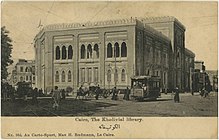Egyptian National Library
| Egyptian National Library | |
|---|---|
|
|
|
| founding | 1870 |
| Duration | 2 million media units |
| Library type | National Library |
| place |
Cairo |
| operator | state |
| Website | Website of the Egyptian National Library |
The Egyptian National Library ( Arabic دار الكتب والوثائق القومية, DMG Dār al-Kutub wa-l-Waṯāʾiq al-qaumiyya 'National House of Books and Documents', Dar el-Kotob for short in Egyptian Arabic ) in Cairo , known in the Anglo-American language area as the Egyptian National Library and Archives , is the largest public library accessible library of Egypt and one of the most important in North Africa and the Middle East. The national library houses the most extensive manuscript collection in the Arab-Islamic world with over 50,000 copies . The associated Egyptian National Archives are housed in a building annex.
history
The library was founded in 1870 as a palace library ( library of the Khedives ) by the Minister of Education Ali Pasha Mubarak with the permission of the Ottoman Viceroy of Egypt Ismail Pasha . In 1907 the library moved to its current premises in the Bulaq district . By the end of the 19th century, several collections from private property, mosques, schools and government buildings were integrated. In addition to manuscripts (some dated to the 7th century), papyrus scrolls and books, coins were also collected, a total of over 2 million media. The heads of the facility included a. the German orientalists Ludwig Stern (1873–1874), Karl Vollers (1886–1896) and Bernhard Moritz (1896–1911). Since 1952 it has been called the National Library.
2013 were Mameluke Koran manuscripts in the UNESCO program Memory of the World added.
literature
- Allen Kent (Ed.): Encyclopedia of Library and Information Science . Volume 45, Marcel Dekker, New York 1990, ISBN 0-8247-2045-8 , p. 125 ff.
See also
Web links
Individual evidence
- ^ Egypt - Dar Al-Kutub Manuscripts , UNESCO Memory of the World Program , accessed May 18, 2014.

